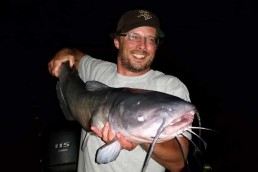North Country Summer Cats
SHARE THIS POST
Here we find ourselves in midsummer—catfish are just wrapping up the spawn in the North and are getting set into their seasonal patterns. This time of year the catfish can be predictable, and easy to catch. While walleye fishermen are in what they call “the dog days of summer,” this is our time. Catfish have taken up residence and are living out their lives until the next chapter this year sets and tells them to move.
When searching for catfish in rivers in July, you have to be willing to move and adapt to catch good numbers. While these fish become very predictable, they are living in their own neighborhoods and you have to dissect the spots.
Considering that river and weather conditions are normal, catfish will make their homes in areas of a river where there’s a combination of deep water, expansive runs and structure such as snag piles. The fish use all of these for feeding, resting and living throughout the summer.
Now that you know where to fish, it’s time to find the bait of choice. If you aren’t sure, get online or call the local bait shop to see what they’ve been hearing for reports: shad, suckers, frogs, goldeyes, etc. Once you get to the area—again, figuring that water levels and clarity is normal—begin by casting into the fastest water in the spot at the head of a hole. If you’re fishing from a boat, give it 15 to 20 minutes before moving if you don’t get bit. If you’re on the shore, give your cast a solid one half hour.
If you are not met with success, move your baits to the upstream side of a wood snag nearest the deeper water. Repeat the move, and be ready to perhaps adjust your casts and freshen up your baits once.
Are you enjoying this post?
You can be among the first to get the latest info on where to go, what to use and how to use it!
Now, at this juncture you should’ve caught a catfish, under most conditions. If you haven’t made contact, it might be the right time to start looking for a new stretch of river. But if you have located the active fish, then it’s just a matter of keeping your bait fresh and working that area completely to put fish on your line.
As early evening becomes night, the catfish in your locations will start to come out to feed. Instead of going to the cats like you did all day, let them come to you. As nighttime falls, set your baits on the flats in front (upstream edges) of the holes or along drop-offs along the banks to set up an ambush point for hunting the catfish. Also, take to time to sit back and enjoy an evening under the stars with a campfire.
Catfish hunt at night, so it might be wise to consider using live baits to cause the necessary commotion to trigger a bite. During more “wet” years in terms of rainfall amounts, it can be a great time to use leopard frogs for bait, especially at night. Frogs tend to come out after dark to feed on bugs and to migrate back to bigger bodies of water from ponds and ditches. This nighttime migration can actually shift the bait preference from a cut fish during the day to a frog during the night.
Now you have what it takes to get you started to catch the summer catfish. Of course, there can be so much more to go into should there be high water or a time with an unstable weather pattern. But for halfway- normal conditions, you now have all the info you need. There’s no time like now to get out and enjoy the hard-fighting catfish in your area.
MWO
SHARE THIS POST
Did you enjoy this post?
You can be among the first to get the latest info on where to go, what to use and how to use it!
Brad Durick
Captain Brad Durick is a nationally recognized catfish guide, seminar speaker, and author of the books Cracking the Channel Catfish Code and Advanced Catfishing Made Easy. For more information: redrivercatfish.com or facebook.com/braddurickoutdoors.



